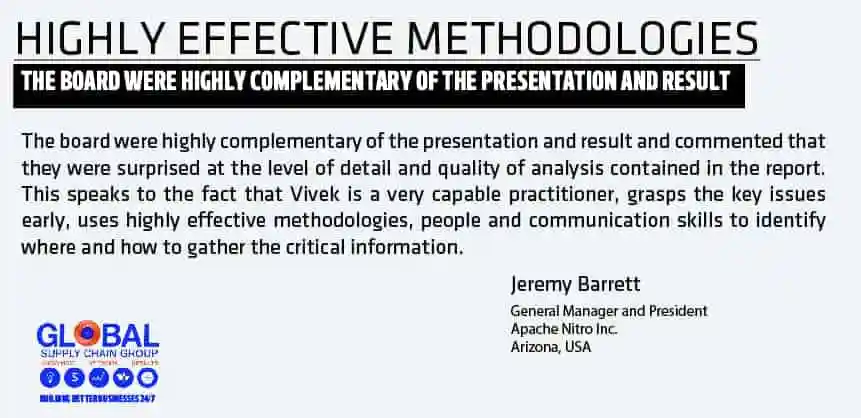FAQs (Frequently Asked Questions) On Supply Chain Training And Courses
Overview
FAQs On Supply Chain Training And Courses
We have been providing supply chain training to our clients since when none of the universities offered any courses in supply chain management, and most of the current supply chain associations either did not exist or were associations for logistics, procurement, inventory control, production, warehousemen, etc. To see our full training offering see our training brochure. These FAQs reflect our considered opinion – though it might come across as biased.

It is normal to feel the overwhelm due to the sheer number of options in supply chain training today. I will try and answer you question, and also add which type of trainings are suitable for which type of supply chain personnel. That will also give you an idea where do focus. Firstly, it is important to be cognisant that the training needs for Vice-President level is not the same as the training need for the forklift driver level. They play a very different role in the supply chain. I am making this very obvious point to introduce the following four level hierarchy in supply chain activities extracted from our book Unchain Your Corporation:

The bottom layer in this picture consists of procurement officers writing purchasing order, inbound truck drivers bringing in the supplies, staff in manufacturing and warehouses receiving the supplies, the assembly line workers deployed in manufacturing, forklift drivers taking the products away from the factories, warehousemen stowing the product in the sheds, pick and pack staff preparing the deliveries, delivery drivers taking the goods to customers and finally customer support teams answering all the questions.
The next layer upwards are supervisors and foremen who schedule and manage these staff. The training needs of these two layers cover basics of the overall supply chain and a very detailed picture of their own task in that supply chain. For example, the forklift drivers need a lot of training in driving forklifts, safety in warehouses, occupational health, pick-to-light technology (or any other similar technology deployed) etc. Clearly they do not need training in intricacies of the latest demand forecasting statistical algorithms using big data. Most of the certification focused courses are run by organisations with origins in transportation, logistics, warehousing, inventory planning, production planning etc and the content is highly relevant to the middle two layers.
The tactical planning layer focuses on one part of the overall supply chain planning process – demand planning, supply planning, fulfilment planning, sales and operations planning, distribution planning, inventory planning – and their training focuses on that part, as well as how it links to the big picture. Many organisations try and offer training in this area. Some are really good, but many fail due to the content being more suitable for the lower levels (or the higher level), rather than the targeted level.
The highest layer in the pyramid caters to the top of the organisation – VPs and CEO, and at this level the focus is on making sure all the planning, execution and controls are in place so that the supply chain continues to be efficient and effective. There are very few organisations that have the capability to offer specialist supply chain training in this area.
In the rest of the FAQs we will refer to these four layers all the time to explain the supply chain training landscape in more detail. So to read the rest of your answer keep reading the next few questions and you will know a lot more about who is who in the zoo. Finally, at the end we have an easy 2 minute quiz which can guide you in the right direction depending on the training needs of your organisation.
No, the supply chain business-as-usual (BAU) team is charged with making sure that supply chain keeps humming efficiently day in and day out.
Difficult though this job is, the job of the supply chain transformation (SCT) team is far more difficult. They have to ensure that a humming supply chain, hums better without missing a beat while this transformation happens. We have written several articles on the difference between the two teams which are worth exploring in great details if you are charged with training of both the teams.
That is a very good question, though somewhat unexpected. Training has become the norm for a variety of reasons. But before we go into those, let me first state that on-the-job training is THE BEST way of training any professional in supply chain, provided the trainer is fully vested in the process, is a capable practitioner at the right level, and takes the pain to provide work that created opportunities for learning. At the same time, the trainee needs to be even more vested in the process and take all the opportunities with both hands and move positively.
Generally, most big companies do not have all these ideal conditions.
In fact, people do not want to train their own replacements fearing for their jobs. Moreover, the capability set is mostly outdated because supply chains evolve by an entire generation every ten years.
Now combine these facts with the situation where many universities have become degree factories focusing on the certification rather than on the learning and you are left with half mature raw workforce coming in with very high opinion of their capabilities and low ability and willingness to absorb new material readily – and you have a recipe for disaster if you replied solely upon on-the-job training.
That is why you need off-the-job training that is relevant, interesting, entertaining, engaging, topical and frequent.
Look for our courses in as an example of such training.
We have seen some very experienced but argumentative middle level staff from first generation supply chain milieu almost ruining the training for the entire cohort when they fail to recognise the difference between a third generation supply chain in their current employer, and the first generation supply chain in their previous employer.
So, yes depending on the argumentativeness and the experience of the person that possibility dues exist. But good trainers come prepared for this eventuality, armed with clear collateral showing the supply chain differences between industries, supply chain generations, and geographies.
When I did my MBA in 1995-96 from one of the best businesses schools in the world, there was not a single MBA level supply chain course in the entire world.
Operations management and industrial engineering were the two early streams of study that were closely related to the supply chain management arena.
But the Operations management and industrial engineering continued as two separate entities till the peak times of world war II. During this time the need for improvements in military logistics skyrocketed and the new branch of study was born integrating core values of operations management and industrial engineering.
In 1963 the National Council of Physical Distribution Management was formed and it was the predominant organisation in the field of managing the physical flow of goods though a chain, though the name supply chain management was not yet coined.
When our senior partner Dr Wolfgang Partsch and his team coined the term supply chain management in 1978, they created and trained people in the methodology to study the four flows (at that time fifth flow was – risk was not considered) of the supply chain.
For the first two decades of its existence, supply chain management field was largely ignored – both by the universities and the certification bodies.
Meanwhile, with outstanding real world results, savvy companies and their top consultants continued to progress the thought leadership in supply chains, and popularize the concept of five flows and integration / optimisation matrix. I still remember in 2003 being asked on a golf course ‘what kind of chains does your company (GLOBAL SUPPLY CHAIN GROUP) supply?’
Seeing the outstanding success of supply chain concepts, eventually most universities and business schools jumped on the bandwagons and created courses, or even entire degrees focused on supply chain management.

At the same time certification bodies who were formerly training inventory analysts, production planners, warehousemen, logisticians, and even drivers and purchasing officers started incorporating supply chain terminology in their course materials and nomenclature.
That is how we have arrived at the situation where we are today and that is one of the reasons for the confusion about the plethora of courses and their varying level of quality and coverage of key supply chain concepts.
Best places to do these courses are your national bodies catering to these respective disciplines. They may have a title with the word supply chain in it – e.g. Nigerian Institute of Supply Chain and Logistics, or Thailand Association of Procurement and Supply Chain, etc – but in reality their history and membership will easily show that they are predominantly catering to one of the disciplines you are looking for.
The reason for recommending these national bodies is simple – they are most involved in formulating of the local legislation related to that area of supply chain, and are most up to date in operational legislation affecting day-to-day execution and scheduling of work in that arena. Standard operating procedures (SOPs) are generally closely aligned with the legislation in the country which must be adhered to by all operators.
You could also look for operational level consultants in the local geography who specialise in training in that area of expertise – and they can be sometimes better than the national bodies.
There are many organisations which offer certification in supply chain management and following are only the most important organisations who give the valuable and most sought after certifications in supply chain management.
- Association for Supply Chain Management (APICS)
- Institute for Supply chain Management (ISM)
- Council of Supply Chain Management Professionals (CSCMP)
- SOLE – The International Society of Logistics
- National Contract Management Association (NCMA)
Many of these names already signify which part of supply chain they cater to. Ask for the membership details and previous names in order to make a judgement about what part of supply chain would their training mostly focus on. They certify thousands of operational level supply chain managers and in our considered view certificates are very useful for tier 4 and tier 3 roles in BAU supply chain jobseekers to distinguish themselves from uncertificated cohorts.
This is a very tricky question to answer.
Where the certificate is mandated by a national or state regulatory authority, they also what kind of certificate in acceptable in lieu and a bridging process if one exists for other common similar certificates. You have to make very careful enquiries with very specific details before you make any decisions.
On the other hand, when a company asks of a certain certification, they will generally accept most of the other respected international certifications in lieu.
In general, supply chains follow similar standards all over the world and the skills are transferable with ease across the geographies. In some scenarios, a bridging of certifications may become a requirement as the norms and standards followed by some nations like the USA, Philippines etc are different from the current international standards used.
Following are some of the relevant courses. Please beware that we do not endorse any courses or institutes – you will have to do your own due diligence about their content, appropriateness and level. Clearly such a short list cannot be exhaustive – there are many more courses in each of these geographies.
The major Supply chain courses offered in the USA are
- APICS Certified Supply Chain Professional certification (CSCP),
- APICS Certified in Production and Inventory Management (CPIM),
- APICS Supply Chain Operations Reference (SCOR-P) Endorsement,
- NCMA Certified Professional Contract Manager (CPCM).
The UK supply chain courses are:
- Professional Diploma in Procurement and Supply – L6 offered by Chartered Institute of Procurement and Supply (CIPS),
- Certificate in Supply Chain Finance (CSCF) offered by The London Institute of Banking & Finance and so on.
Australian courses
- Certified Supply Chain Professional (CSCP),
- Certified in Logistics, Transport and Distribution (CLTD),
- Certified Professional in Supply Management (CPSM) and
- Certified in Production and Inventory Management (CPIM)
Germany:
- Global Supply Chain and Operations Management offered by Hochschule für Wirtschaft und Recht Berlin and
- Program in Transport & Logistics Management offered by International University of Applied Sciences Bad Honnef
India
- Export Trade and Training Institute Mumbai,
- International Institute of Procurement and Market Research (IIPMR) Tamil Nadu and
- Institute of Shipping Jaipur
Here are some common online courses that we have heard about. We do not endorse any of these courses and do not know what level they cater to.
- Supply Chain Management: Be Global by Coursera,
- Supply Chain Foundations by LinkedIn Learning,
- Operations and Supply Chain Management by Udemy,
- Supply Chain Technology and Systems by edX,
- Supply Chains for Manufacturing I by edX,
- Supply Chain Risk Management by Udemy
Massive Open Online Courses (MOOC) are good to understand the basics of supply chain, or even to upgrade your knowledge base in supply chain. But, like all other courses, they cannot guarantee landing a suitable job or promotion. At best they can strongly support your candidature for the job or promotion.
For freshers, these courses will give them virtual exposure into the modern supply chain environment and provide them with the lay of the land about to advanced standards that exist inside the industry.
The best way to judge the credibility and capability of the course provider is to ask their alumni critical questions about the progress they have been able to achieve as a direct result of what they learned in the course, or by holding the certificate awarded by the course.
If the course fails this litmus test then all other discussion about it is merely window dressing.
While assessing this progress also try and assess the quality of participants in the course, because you learn almost as much from the other participants questions and observations as you learn from the formal course content.
A good course would also structure a number of breakout sessions and group activities to facilitate learning, interaction and cross seeding of ideas.
Most of our trainings and courses fall under this category. These were originally built on demand of our clients – senior executives in large multi-national corporations who were disillusioned by the courses run by renowned global universities such as Stanford and Columbia due to paucity of usable breakthrough supply chain concepts coming out of those courses.
There are four critical differences – each of them are equally important:
1. Strategic focus: At levels one and two, the strategy of the business unit, and the company as a whole become paramount. Every action of the supply chain is moulded by the overall strategic focus. This will sound very theoretical and abstract to those who are not well versed in strategic thinking. So let me make it real by giving an example from my book “Unchain Your Corporation”:
The second equally important realization was that their entire business was really just a supply chain business. They were in the business of buying, storing and selling products, which is not very different from lot of other businesses around the world these days.
As manufacturing has moved to China, India, Vietnam, Bangladesh or other foreign locations, many businesses in Europe, United States, Australia or other developed countries have effectively become supply chain businesses where they buy products from these manufacturers.
They store those products and sometimes do minor value addition during storage in their premises before weaving in a service offering to finally provide customer delight at the point of delivery.
Frank understood the importance of supply chain but he was grappling with a very important issue. The supply chain manager had been a logistics consultant before coming into his business and rated his own supply chain capabilities very highly. This man had built a team of very loyal logisticians inside the company. Every time there was any discussion on supply chain, he would roll out key performance indicators related to logistic operations showing clearly how good the logistic operation was.
Frank was at a loss to understand why the profitability of the business was so low when all the key performance indicators shown by his supply chain manager painted such a positive picture. On top of it, other individuals in his business including a financial analyst in the accounting department and some other people in the procurement department had very different opinion about the logistics operation than the supply chain manager.
In fact, everybody in the business had very different opinions of what supply chain was and how it should be run. Tradition-bound people said: “All we do is bring in the product, store it and sell it. We will sell it to anybody where we make the money for the same price”. Sophisticated marketers had segmented the market place very carefully, differentiating prices based on customers’ ability to pay as well as their willingness to pay for extra service that came with the product.
This is not very different from the fact that you pay a far lower price for a can of coke in a supermarket than you pay for the same can of coke at Bondi Beach in Sydney.
Back to Frank’s business – on one hand, there were very sophisticated market segmentation exercises with a well-articulated service promise; on the other, a very rudimentary supply chain where the same supply chain model was servicing every customer segment in exactly the same way. So you would get the same kind of warm coke whether you went to supermarket or to the beach shack in the middle of a summer heat wave despite the price differential between the two places.
Needless to say, customers who were paying much higher prices, were very dissatisfied with the service as well as the product. In their perception, the company did not deserve to charge the high price, whereas, those who were paying the basic price were delighted because they were getting services which they were not getting anywhere else.
Exacerbating this external customer reality was the internal reality of different supply chain sophistication levels within Frank’s company. The logisticians were very efficient operators, cutting every possible penny. On the other hand, the marketing team were very sophisticated, contending that for high value customers, we should not be watching pennies. They are paying much higher price and we should be looking at reconfiguring a different supply chain for those customers.
At the same time, financial analysts held a view of the traditional supply chain (SCM 1.0), with clear silos within the company moving towards low cost country sourcing. This diversity of opinions created a massive confusion within the company.
On his appointment as Chief Supply Chain Officer, Frank asked us to help clear the confusion and, simply because we were detached from the emotionality inherent in the internal debate, we could easily recognize the chains that were slowing down his company’s growth.
2. Emphasis on the soft skills – Look at the supply chain skills pyramid we use in our training:

There are four facets to supply chain skill set. At the higher level soft skills become far more important than the technical supply chain skills.
In fact we have seen many VP level or higher executives (including the one in the case study quoted) in supply chains succeed solely based on those soft skills when they barely had any hard supply chain skills. It is a reality of life that at higher level soft skills become critical while supply chain skilled work can be delegated to lower levels.
At level 1 and 2, your core supply chain skills are critical. You cannot survive in your job without them. If you are a sales and operations planner, you need to know what that means and how it is done. If you are a VP of supply chain – you many not need to because you have a sales and operations planner to do the job, and your role is to only clear the path for them.
2. Wider set of skills – If at lower levels a deeper level of skills in a narrow area is important, then at the higher levels a wider set of skills is critical. Ideally you would also have the depth of knowledge along with the width of skill base, but if you do not – width of skill base is more important than the depth of knowledge at the higher levels.
3. more updated set of skills and knowledge – Everything in supply chain gets updated every few years. But the rate of change at the top is much faster than it is at the lower levels. For example demand planning is demand planning for the last 30 years. Sure the software has updated, and big data is starting to creep in but those updates are slow to come and easier to imbibe. On the other hand, supply chain strategy keeps updating every 3-5 years and brings in massive change at the top level. Out book Unchain Your Corporation is full of more than 200 case studies illustrating this key point.
Stanford, IMD and MIT – all have good executive education courses though we believe our executive courses are better tailored and delivered at a lower price point.
AT MBA level, unfortunately, most courses are run by PhDs who barely have any operational or even strategic experience in real life organisational supply chains. As a result, the discussion is far too theoretical with lots of suppositions that negate the entire art of supply chain management – a very practical discipline born and raised in the crucible of real life businesses.
If you are a novice to the field in supply chain – we would recommend spend $9 and get hold of our report “Everything You Wanted to Know About a Career in Supply Chain Management” because it will give you a good understanding of how to get in and how to progress in the field of supply chain management. This is the only report we have priced this low for the simple reason that it is useful for the students who pay from their own pockets and can only afford low prices for dispensable items such as career advice.
After reading this report you may decide to pursue an MBA or PGDM, or a certificate course, or something else. But you will make much more informed decision based on your personal motivation and market reality.
The answer to this questions is simple – it depends on what level they are working at, and what level do they want to get to.
If you are a head of supply chain who wants to get to the CEO level in your career then this course – “Journey From The is a unique course not offered anywhere else. We have worked on this journey alongside many current CEOs so we know the milestones and the shortest path to the top.
If you are a recent appointee to the position of the head of supply chain, and want to maximise your impact and contribution then this course- is for you. Again, it is not based on any book, or theory – it is based on solid work experience of decades in companies such as yours. In fact if you go to our section, you are likely to find many courses that will suit your specific situation. Choose one or two, but not more because there might be some cross-overs between these courses.
Given their low price point, cannot see how they can hurt your career progression unless you get too married to any redundant ideas or fallacies you pick up in one of these courses.
Why We Are Qualified To Write This List Of FAQs On Supply Chain Training And Courses?

VERY FEW PEOPLE KNOW SUPPLY CHAINS LIKE WE DO – retail, beverages, food, milk, dairy, meat, livestock, explosives, chemicals, cotton, rice, graphite, solar power, natural gas, crude oil, fertilizers, electronics, packaging, glass manufacturing, machine parts, automobiles, industrial goods, mining, etc are just some of the industries where boards and executives have benefited from our proprietary knowledge of the supply chain analytics. Since when few had heard of supply chain, our co-founder Vivek Sood has been considered one of the most authoritative professionals in the field when it comes to the subject of supply chain in Australia, Asia, North America, South America and Europe. He has written four seminal books about using supply chains to gain massive advantage in business. He also regularly delivers keynote speeches at business schools and conferences such as University of Technology Sydney, Supply Chain Asia, Asian Bankers Forum, APEC Business Advisory Council.
He has been quoted in the authoritative business press and over 100 academic papers written by supply chain researchers around the world. Vivek and his team have examined thousands of supply chains during their projects over the last three decades and helped hundreds of executives build safe, cost effective and sustainable supply chains and careers.
meet our team

Vivek Sood
Over 300 projects covering 83 countries in the last 18 years, 100% success rate
MBA (AGSM) , LLM (London), CFA
A prior career in Merchant Navy – rose to Master Mariner; very pragmatic

Dr Wolfgang Partsch
Co-invented “Supply Chain” in 1979.
Legendary project successes include Red Bull, Mercedes, and Ferrari.
Over 500 projects in SCM.

Lin (Emilio) Giralt
30 years of work experience (19 in consulting)
BA – Duke University,MBA – Wharton School, University of Pennsylvania
Global supply chain Clients feedback
What Do People who matter Say About Us?







P & L Executive

Coats Group plc

Credence Logistics
